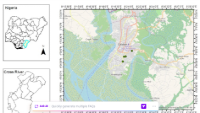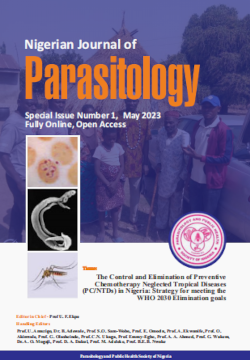Analysis of Parasitic Infections in <i>Oreochromis niloticus</i> and <i>Clarias gariepinus</i> Obtained from Selected Fish Farms in Calabar, Nigeria
DOI:
https://doi.org/10.4314/njpar.v46i1.5Keywords:
Clarias, Oreochromis, Prevalence, Fish parasites, AquacultureAbstract
Freshwater fish species harbour parasitic organisms, serving as either intermediate or definitive hosts for parasites that can be harmful to humans and animals. This study was conducted to assess the prevalence of parasites in two fish species obtained from selected farms in Calabar, Nigeria. Collection, examination, sex determination, and identification were performed using the recommended procedures. A total of 300 fish samples from four fish farms were examined for parasites, and 88 (29.3%) were found to be infected. The highest prevalence of parasitic infection was observed at the Nyahansang fish farm (41.3%), whereas the lowest prevalence was recorded at the University of Calabar (UNICAL) fish farm (18.7%). Gyrodactylus sp. (8.3%) were the most prevalent parasites, followed by Trichodina spp. (6.7%); Dactylogyrus sp. (4.7%); Aeromonas sp. (3.0%); Eustrongylides sp. (2.3%); Henneguya pinnae (2.3%); Ergasilus labracis (1.3%); and Chilodonella sp. (0.7%). Oreochromis niloticus had the highest parasite prevalence (54 [36.0%] ) compared to that of Clarias gariepinus (34 [22.7%] ). The prevalence of parasites was higher in females (31.4%) than males (27.2%). In O. niloticus, 25 males (34.2%) and 29 females (37.7%) harboured parasites, but the comparison between sexes showed no significant difference (p>0.05). Similarly, in C. gariepinus, 15 males (20.3%) and 19 females (25.0%) harboured parasites, with no significant difference observed between the sexes (p>0.05). This study revealed the considerable prevalence of parasitic infections in the two fish species used. The results of this study highlight the potential risks posed by parasites on aquaculture, fish health, and economic sustainability. A deeper understanding of these parasitic dynamics is crucial for enhancing fish health, improving aquaculture productivity, and fostering sustainable fish farming practices in Nigeria.
References
Beveridge, M. C., Thilsted, S. H., Phillips, M. J., Metian, M., Troell, M., & Hall, S. J. (2013). Meeting the food and nutrition needs of the poor: the role of fish and the opportunities and challenges emerging from the rise of aquaculture. Journal of Fish Biology, 83(4): 1067 - 1084. https://doi.org/10.1111/jfb.12187
Ejere, V. C., Aguzie, O. I., Ivoke, N., Ekeh, F. N. , Ezenwaji, N. E., Onoja, U. S., & Eyo, J. E. (2014). Parasitofauna of five freshwater fishes in a Nigerian freshwater ecosystem. Croatian Journal of Fisheries, 72:17-24. https://ribarstvo.agr.hr/articles/75125_PARASITOFAUNA_OF_FIVE_FRESHWATER_FISHES_IN_A_NIGERIAN_FRESHWATER_ECOSYSTEM_en.pdf
Keke, U. N., Arimoro, F. O., Ayanwale, A. V. & Oghenemarho, I. A. (2017a). Rotifer (Brachionus calyciflorus) could compete favourably with Artemia nauplii as alternative starter for African Catfish (Clarias gariepinus). Applied Science Research Journal, : 41 - 58.
Abdel-Gaber, R., Garhy, M. & Morsy, K. (2015). Prevalence and intensity of helminth parasites of African catfishClarias gariepinus in Lake Manzala, Egypt. Advances in Bioscience and Biotechnology 6:464 – 469. http://dx.doi.org/10.4236/abb.2015.67048
Abd-ELrahman, S. M., Gareh, A., Mohamed, H. I., Alrashdi, B. M., Dyab, A. K., El-Khadragy, M. F., Khairy Elbarbary, N., Fouad, A. M., El-Gohary, F. A., Elmahallawy, E. K., & Mohamed, S. A. (2023). Prevalence and morphological investigation of parasitic infection in freshwater fish (Nile Tilapia) from Upper Egypt. Animals, 13(6):1088. https://doi.org/10.3390/ani13061088
El-Asely A. M., Abd El-Gawad, E. A., Soror, E. I., Amin, A. A. & Shaheen, A. A. (2015). Studies on some parasitic diseases in Oreochromis niloticus fish hatchery with emphasis on life stages. Journal of Advances in Veterinary Research, 5(3): 99 – 108. https://www.semanticscholar.org/paper/Studies-on-Some-Parasitic-Diseases-in-Oreochromis-Asely-El
Gawad/9bd8e46c441350c16dd9d5043e425e3f66c40d6f
Iqbal M. N. & Ashraf, A. (2017). Buffalos in Pakistan: Incidence and control of gastrointestinal parasitic infections in naturally infected water buffaloes. Veterinaria 1: 28-31. https://pubs.thepsm.net/issues/buffalos-in-pakistan-incidence-and-control-of-gastrointestinal-parasitic-infections-in-naturally-infected-water-buffaloes/
Saad, S. M., Salem, A. M., Mahdy, O. A. & Ibrahim, E. S. (2019). Prevalence of metacercarial infection in some marketed fish in Giza Governorate. Egypt Journal of Parasitology, 49:129-134. https://doi.org/10.21608/jesp.2019.68295.
Chai, J. Y., Murrell, K. D. & Lymbery, A. J. (2005). Fish-borne parasitic zoonoses: Status and issues. International Journal Parasitology, 35: 1233–1254. https://doi.org/10.1016/j.ijpara.2005.07.013.
Hadyait, M., Ali, A., Bhatti, E., Qayyum, A. & Ullah, M. (2018). Study of proximate composition of some wild and farmed Labeorohita and Cirrhinusmrigala fishes. PSM Biological Resources, 3: 34 - 38 . https://psmjournals.org/index.php/biolres/article/view/163
Cross River State Government. (n.d.). Cross River State: physical. https://kekerete.tripod.com/CRSG/physical.html (accessed 10 May 2024).
Reed, W., Buchard, J., Hopson, A. J. & Yaro, I. (1967). Fish and Fisheries of Northern Nigeria. Ministry of Agriculture, Kaduna, Northern Nigeria, 226 p.
Olaosebikan, B. D. & Raji, A. (1998). Field Guide to Nigerian Freshwater Fishes. Federal College of Freshwater Fisheries Technology, New Bussa, Nigeria. Pp. 67. https://doi.org/978-34-7600-9
Imam, T. S. & Dewu, R. A. (2010). Survey of Piscine ecto and intestinal parasites of Clarias sp. sold at Galadima road fish market, Kano metropolis, Nigeria. Bioscience Research Communication, 22(4): 209 – 214. https://www.researchgate.net/publication/280925323_Survey_of_piscine_ecto-_and_intestinal_parasites_of_clarias_species_sold_at_Galadima_Road_Fish_Market_Kano_metropolis_Nigeria
Paperna, I. (1991). Diseases caused by parasites in the aquaculture of warm water fish. Annual Review of Fish Diseases 1: 155 - 194. https://doi.org/10.1016/0959-8030(91)90028-I
Bichi, A. H. & Ibrahim, A. A. (2009). A survey of ecto and intestinal parasites of Tilapia zilli (Gervais) in Tiga Lake, Kano, Northern Nigeria. Bayero Journal of Pure and Applied Science, 2(1): 79 - 82. https://doi.org/10.4314/bajopas.v2i1.58472
El-Shahawy, I., El-Seify, M., Metwally, A., & Fwaz, M. (2017). Survey on endoparasitic fauna of some commercially important fishes of the River Nile, Southern of Egypt. Review De Medical Veterinary, 168:126–134. http://www.revmedvet.com/2017/RMV168_126_134.pdf
Hoffman, G. L. (1998). Parasites of North American Freshwater Fishes. Cornell University. Press, London, UK, 2nd Edition.
Tesfaye, Z., Hiko, A., Kitila, D. & Firdisa, M. (2023). Assessments and identification of selected fish-borne zoonotic parasites in Nile Tilapia and African catfish species in Lakes of Haramaya District, Ethiopia. Aquaculture Research, 2023: 1-17, https://doi.org/10.1155/2023/2638123.
Adewole, H. A., Salawu, S. A., Onana, E. E., Ogunjimi, P. O., Adesokan, R. A. & Faleye, A. L. (2023). Survey of parasitic fauna of some fishes from Osun River, Osun State, Southwestern, Nigeria. International Journal of Fisheries and Aquatic Studies, 11: 32-41, https://doi.org/10.22271/fish.2023.v11.i5a.2846.
Simon-Oke, I. A. (2016). Diversity, intensity and prevalence of parasites of cichlids in polluted and unpolluted end of Eleyele Dam in Ibadan, Oyo State. Advances in Aquaculture and Fisheries Management, 4(1): 1-6. https://www.redalyc.org/journal/5156/515653587006/html/
Amaechi, E. C. (2015). Prevalence, intensity, and abundance of endoparasites in Oreochromis niloticus and Tilapia zilli Pisces: Cichlidae) from Asa Dam, Ilorin, Nigeria. Cuadernos de Investigation UNED, 7(1): 67 – 70.

Downloads
Published
How to Cite
Issue
Section
License
Copyright (c) 2025 Nigerian Journal of Parasitology

This work is licensed under a Creative Commons Attribution-NonCommercial-NoDerivatives 4.0 International License.




